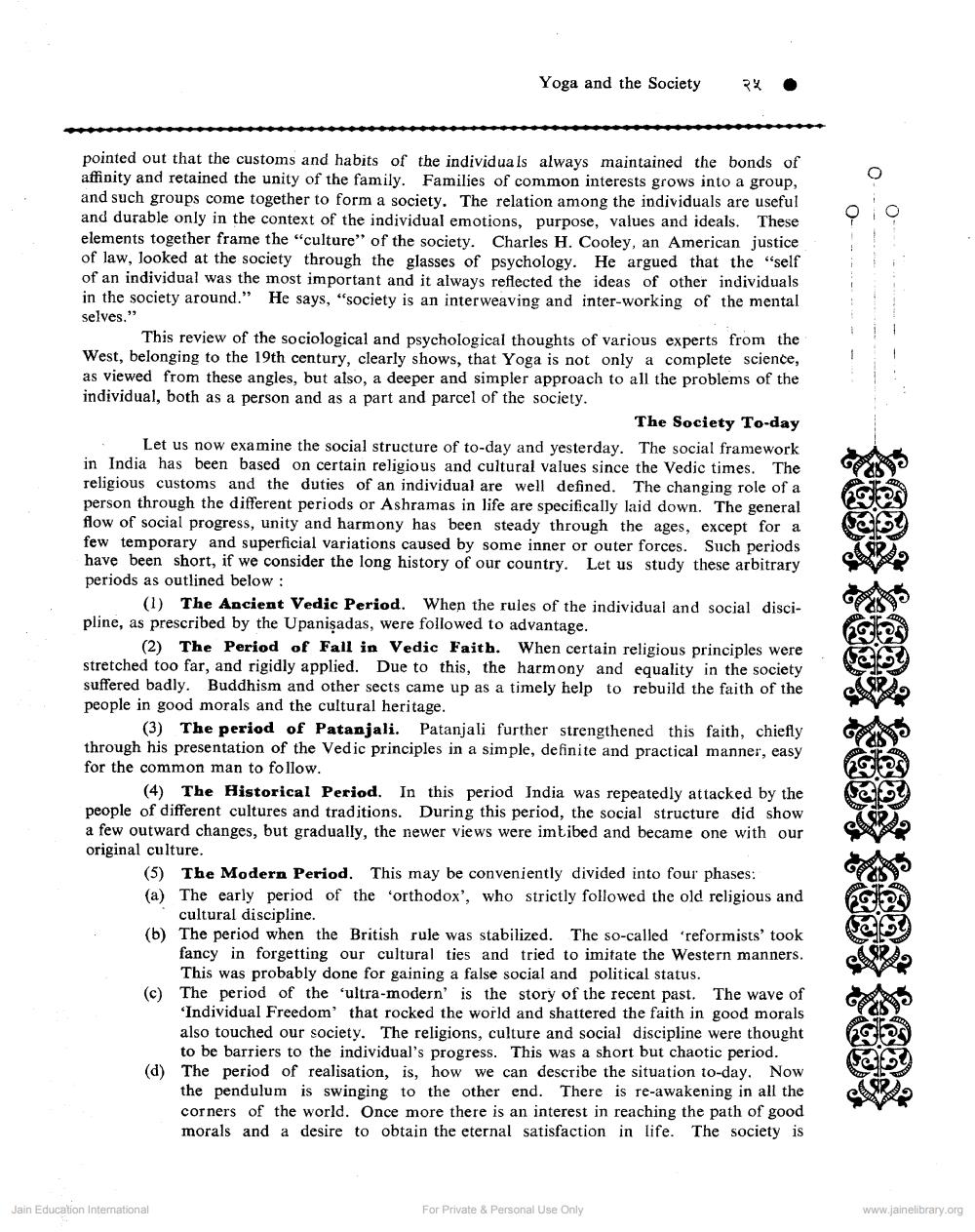Book Title: Yoga and the Society Author(s): R V Ranade Publisher: Z_Pushkarmuni_Abhinandan_Granth_012012.pdf View full book textPage 2
________________ Yoga and the Society २५ Q10 pointed out that the customs and habits of the individuals always maintained the bonds of affinity and retained the unity of the family. Families of common interests grows into a group, and such groups come together to form a society. The relation among the individuals are useful and durable only in the context of the individual emotions, purpose, values and ideals. These elements together frame the "culture of the society. Charles H. Cooley, an American justice of law, looked at the society through the glasses of psychology. He argued that the "self of an individual was the most important and it always reflected the ideas of other individuals in the society around." He says, "society is an interweaving and inter-working of the mental selves." This review of the sociological and psychological thoughts of various experts from the West, belonging to the 19th century, clearly shows, that Yoga is not only a complete science, as viewed from these angles, but also, a deeper and simpler approach to all the problems of the individual, both as a person and as a part and parcel of the society. The Society To-day Let us now examine the social structure of to-day and yesterday. The social framework in India has been based on certain religious and cultural values since the Vedic times. The religious customs and the duties of an individual are well defined. The changing role of a person through the different periods or Ashramas in life are specifically laid down. The general flow of social progress, unity and harmony has been steady through the ages, except for a few temporary and superficial variations caused by some inner or outer forces. Such periods have been short, if we consider the long history of our country. Let us study these arbitrary periods as outlined below: (1) The Ancient Vedic Period. When the rules of the individual and social discipline, as prescribed by the Upanişadas, were followed to advantage. (2) The Period of Fall in Vedic Faith. When certain religious principles were stretched too far, and rigidly applied. Due to this, the harmony and equality in the society suffered badly. Buddhism and other sects came up as a timely help to rebuild the faith of the people in good morals and the cultural heritage. (3) The period of Patanjali. Patanjali further strengthened this faith, chiefly through his presentation of the Vedic principles in a simple, definite and practical manner, easy for the common man to follow. (4) The Historical Period. In this period India was repeatedly attacked by the people of different cultures and traditions. During this period, the social structure did show a few outward changes, but gradually, the newer views were imbibed and became one with our original culture. (5) The Modern Period. This may be conveniently divided into four phases: (a) The early period of the 'orthodox', who strictly followed the old religious and cultural discipline. (b) The period when the British rule was stabilized. The so-called 'reformists' took fancy in forgetting our cultural ties and tried to imitate the Western manners. This was probably done for gaining a false social and political status. (c) The period of the 'ultra-modern' is the story of the recent past. The wave of 'Individual Freedom' that rocked the world and shattered the faith in good morals also touched our society. The religions, culture and social discipline were thought to be barriers to the individual's progress. This was a short but chaotic period. (d) The period of realisation, is, how we can describe the situation to-day. Now the pendulum is swinging to the other end. There is re-awakening in all the corners of the world. Once more there is an interest in reaching the path of good morals and a desire to obtain the eternal satisfaction in life. The society is Jain Education International For Private & Personal Use Only www.jainelibrary.orgPage Navigation
1 2 3 4 5 6
